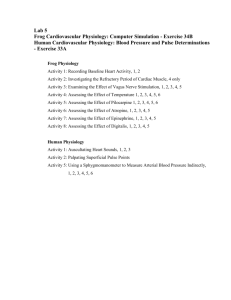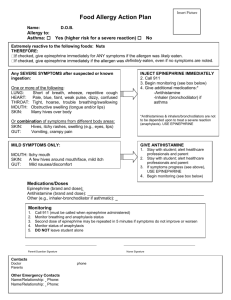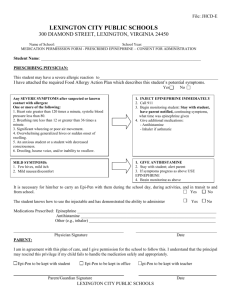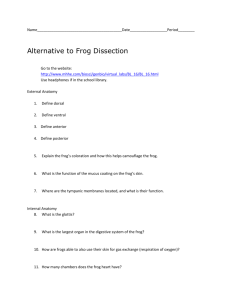Frog & Human Cardiovascular Physiology Lab Manual
advertisement
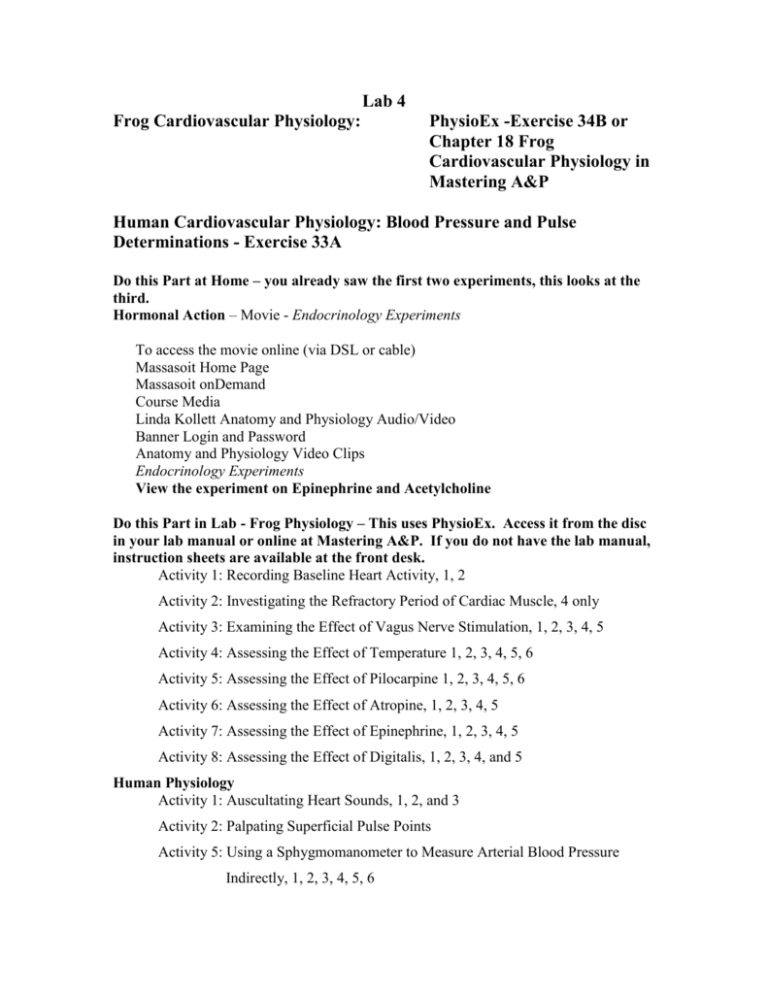
Lab 4 Frog Cardiovascular Physiology: PhysioEx -Exercise 34B or Chapter 18 Frog Cardiovascular Physiology in Mastering A&P Human Cardiovascular Physiology: Blood Pressure and Pulse Determinations - Exercise 33A Do this Part at Home – you already saw the first two experiments, this looks at the third. Hormonal Action – Movie - Endocrinology Experiments To access the movie online (via DSL or cable) Massasoit Home Page Massasoit onDemand Course Media Linda Kollett Anatomy and Physiology Audio/Video Banner Login and Password Anatomy and Physiology Video Clips Endocrinology Experiments View the experiment on Epinephrine and Acetylcholine Do this Part in Lab - Frog Physiology – This uses PhysioEx. Access it from the disc in your lab manual or online at Mastering A&P. If you do not have the lab manual, instruction sheets are available at the front desk. Activity 1: Recording Baseline Heart Activity, 1, 2 Activity 2: Investigating the Refractory Period of Cardiac Muscle, 4 only Activity 3: Examining the Effect of Vagus Nerve Stimulation, 1, 2, 3, 4, 5 Activity 4: Assessing the Effect of Temperature 1, 2, 3, 4, 5, 6 Activity 5: Assessing the Effect of Pilocarpine 1, 2, 3, 4, 5, 6 Activity 6: Assessing the Effect of Atropine, 1, 2, 3, 4, 5 Activity 7: Assessing the Effect of Epinephrine, 1, 2, 3, 4, 5 Activity 8: Assessing the Effect of Digitalis, 1, 2, 3, 4, and 5 Human Physiology Activity 1: Auscultating Heart Sounds, 1, 2, and 3 Activity 2: Palpating Superficial Pulse Points Activity 5: Using a Sphygmomanometer to Measure Arterial Blood Pressure Indirectly, 1, 2, 3, 4, 5, 6 Name____________________________ Exercise 34B Lab Section ________________ Activity and Review Sheet Uses PhysioEx 1. Match the labels on the figure with the terms below: ___ Direct heart stimulator ___ Stimulator holder ___ Atrial contraction ___ Stimulus rate selector ___ Force transducer ___ Vagus nerve stimulator ___ Frog heart ___ Ventricular contraction ___ Oscilloscope ___ Voltage selector ____________________________________________________________ E A F G H B I C D J Follow the directions in the lab manual or on the handout and answer the following questions. 2. What was the baseline heart rate in beats per minute? ________ 3. a. When the stimulus was applied at a rate of 20 stimuli per second in Activity 2, what was the result? (What did you observe happening?) b. Draw an extrasystole and the compensatory pause that follows. Label the extrasystole and the compensatory pause. c. Using your drawing, when does the extrasystole occur? Circle one. During contraction of cardiac muscle During relaxation of cardiac muscle d. What is the function of the compensatory pause? e. Why is it important that the heart muscle cannot be stimulated to fused tetanus? 4. a. What effect did vagal stimulation have on heart rate? ___________________ b. What is the neurotransmitter for the vagus nerve? _________________________ 5. Based on your data, what general statement can you make about the effect of temperature on heart rate? 6. a. What was the effect of pilocarpine on heart rate? ___________________ b. What is the term for a drug that simulates the parasympathetic nervous system by enhancing acetylcholine release? (Hint: the term is described in Activity 5.) _____________________________________ 7. a. What was the effect of atropine on heart rate? ___________________ b. The text states that atropine blocks the effect of acetylcholine. Do your results support this? _________ Explain your answer. Note: A chemical that is an agonist enhances the effect of another chemical. A chemical that is an antagonist inhibits the effect of another chemical. c. Is pilocarpine an agonist or an antagonist to acetylcholine's effect on the heart? ___________________ d. Is atropine an agonist or an antagonist to acetylcholine's effect on the heart? ___________________ 8. a. What is the effect of epinephrine on the heart? ___________________ b. Which branch of the autonomic nervous system does it imitate? _______________ c. Is epinephrine is an agonist or antagonist to acetylcholine? _________________ 9. a. What is the effect of digitalis on the heart? ____________________________ b. Is its effect more similar to epinephrine or to acetylcholine? _________________ 10. Epinephrine and the Frog Heart. a. What effect did epinephrine have on the force of frog heart muscle contraction? Circle one: strong increase strong decrease mild decrease no effect mild increase b. What effect did epinephrine have on the rate of frog heart muscle contraction? Circle one: strong increase strong decrease mild decrease no effect mild increase c. What gland releases epinephrine as a hormone? Be as specific as you can. d. What advantage might there be to having the heart rate and force of contraction increase during the fight or flight response? 11. Acetylcholine and the Frog Heart. a. What effect did ACh have on the force of contraction? Circle one: strong increase strong decrease mild decrease no effect mild increase b. What effect did ACh have on the rate of heart contraction? Circle one: strong increase strong decrease mild decrease no effect mild increase c. What branch of the ANS releases ACh as a postganglionic fiber neurotransmitter? 12. How do the results of the experiments with the real frog heart compare to your results with the frog heart simulation experiment? (2 points) Ex 33A 1. About how long is the interval between the second heart sound and the following first heart sound? _____________________ seconds. 2. a. Which pulse point had the greatest amplitude? b. Which pulse point had the least amplitude? c. How can you explain this? d. What is your lab partner's average radial pulse rate? ______________ 3. What is the formula for calculating mean arterial pressure? 4. Record data here from the sphygmomanometer. First Trial: Second Trial: Systolic P ________mmHg Systolic P_______mmHg Diastolic P ________mmHg Diastolic P ________mmHg Mean Arterial P _______mmHg (Show your work) Mean Arterial P _______mmHg (Show your work) 5. Why is it important to calculate the mean arterial pressure? In other words, what is its value when studying heart physiology? Name____________________________ Lab Section ________________ Pre-lab Activity - Blood Vessels 1. Arteries Veins (circle one) return blood to the heart. 2. Gas exchange takes place only in the ________________ . 3. The artery with the largest diameter is the ___________ . 4. Veins draining the head and upper extremities empty into the ___________ vena cava. 5. Choosing from artery, vein and capillary, which does each of the following best describe? Round lumen __________________ Walls are primarily endothelium __________________ Walls have a thick tunica media __________________ Walls have a thin tunica media __________________ Valves may be present __________________ Extra elastic layers may be present __________________
